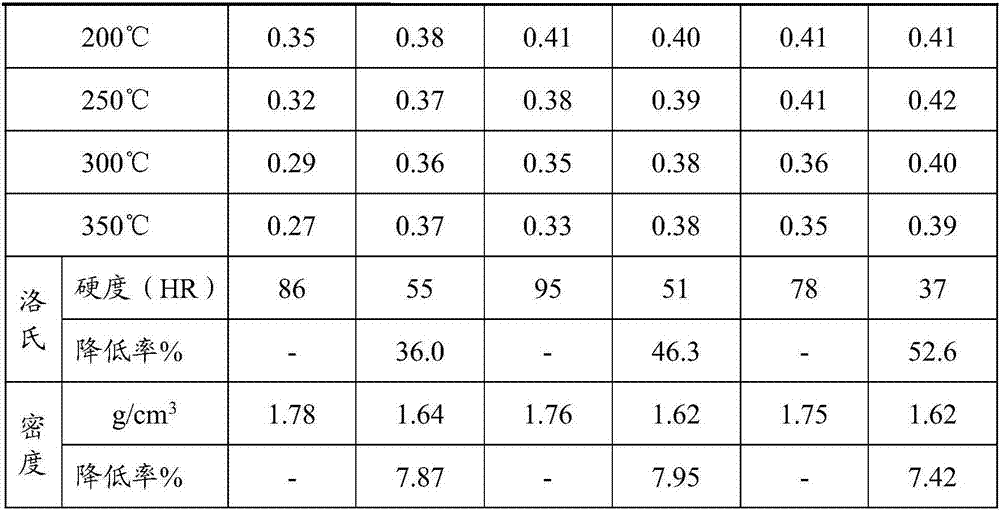Carbon-ceramic friction material as well as preparation method and application thereof
A friction material, carbon-ceramic technology, applied in the field of friction materials, can solve the problems of high braking noise, unstable wear resistance, unstable wear resistance of brake pads, etc.
- Summary
- Abstract
- Description
- Claims
- Application Information
AI Technical Summary
Problems solved by technology
Method used
Image
Examples
preparation example Construction
[0034] The present invention also provides a method for preparing the carbon-ceramic friction material described in the above technical solution, including the following steps:
[0035] Wet mixing each raw material to obtain a mixture;
[0036] The mixture is dried, hot-pressed and carbonized in sequence to obtain a carbon-ceramic friction material.
[0037] In the present invention, there is no special limitation on the order of adding the raw materials, and the order of adding the raw materials well known to those skilled in the art can be adopted. In the present invention, the raw materials are preferably mixed at the same time.
[0038] In the invention, various raw materials are wet-mixed to obtain a mixture. In the present invention, the solvent used for the wet mixing is preferably water, and the mass of the water is preferably 28-35% of the sum of the mass of each raw material, more preferably 30-32%.
[0039] In the present invention, the particle size of the mixtur...
Embodiment 1
[0049] Take 7kg of phenolic resin, 3kg of aramid fiber, 3kg of acrylic fiber, 5kg of paper-based fiber, 15kg of green water slag, 20kg of shale, 20kg of purple sand, 12kg of wheat straw, 3kg of polytetrafluoroethylene, 12kg of barium sulfate, and 28kg of water. The water-wet method is mixed evenly in a vertical one-shaped high-speed mixer to obtain a mixture, and the mixture is microwave-dried to completely remove moisture, and then hot-pressed at 175°C, pressure 15MPa, and hot-pressing rate 50s / mm. Carbonization was then carried out in a tunnel-type carbonization furnace at 800°C for 2h, where the heating rate of the tunnel-type carbonization furnace was 1°C / min, and then cooled naturally to room temperature to obtain a carbon-ceramic friction material.
Embodiment 2
[0051] Take 9kg of phenolic resin, 3kg of aramid fiber, 3kg of acrylic fiber, 5kg of paper-based fiber, 20kg of green water slag, 13kg of shale, 20kg of purple sand, 12kg of wheat straw, 3kg of polytetrafluoroethylene, 12kg of barium sulfate, and 35kg of water. The water-wet method is mixed evenly in a vertical one-shaped high-speed mixer to obtain a mixture. The mixture is dried by microwave to completely remove moisture, and then hot-pressed at 180°C, pressure 20MPa, and hot-pressing rate 70s / mm. Then, carbonization was carried out in a tunnel carbonization furnace at 450°C for 12h, wherein the heating rate of the tunnel carbonization furnace was 2°C / min, and then naturally cooled to room temperature to obtain a carbon ceramic friction material.
PUM
| Property | Measurement | Unit |
|---|---|---|
| Particle size | aaaaa | aaaaa |
Abstract
Description
Claims
Application Information
 Login to View More
Login to View More - R&D
- Intellectual Property
- Life Sciences
- Materials
- Tech Scout
- Unparalleled Data Quality
- Higher Quality Content
- 60% Fewer Hallucinations
Browse by: Latest US Patents, China's latest patents, Technical Efficacy Thesaurus, Application Domain, Technology Topic, Popular Technical Reports.
© 2025 PatSnap. All rights reserved.Legal|Privacy policy|Modern Slavery Act Transparency Statement|Sitemap|About US| Contact US: help@patsnap.com


